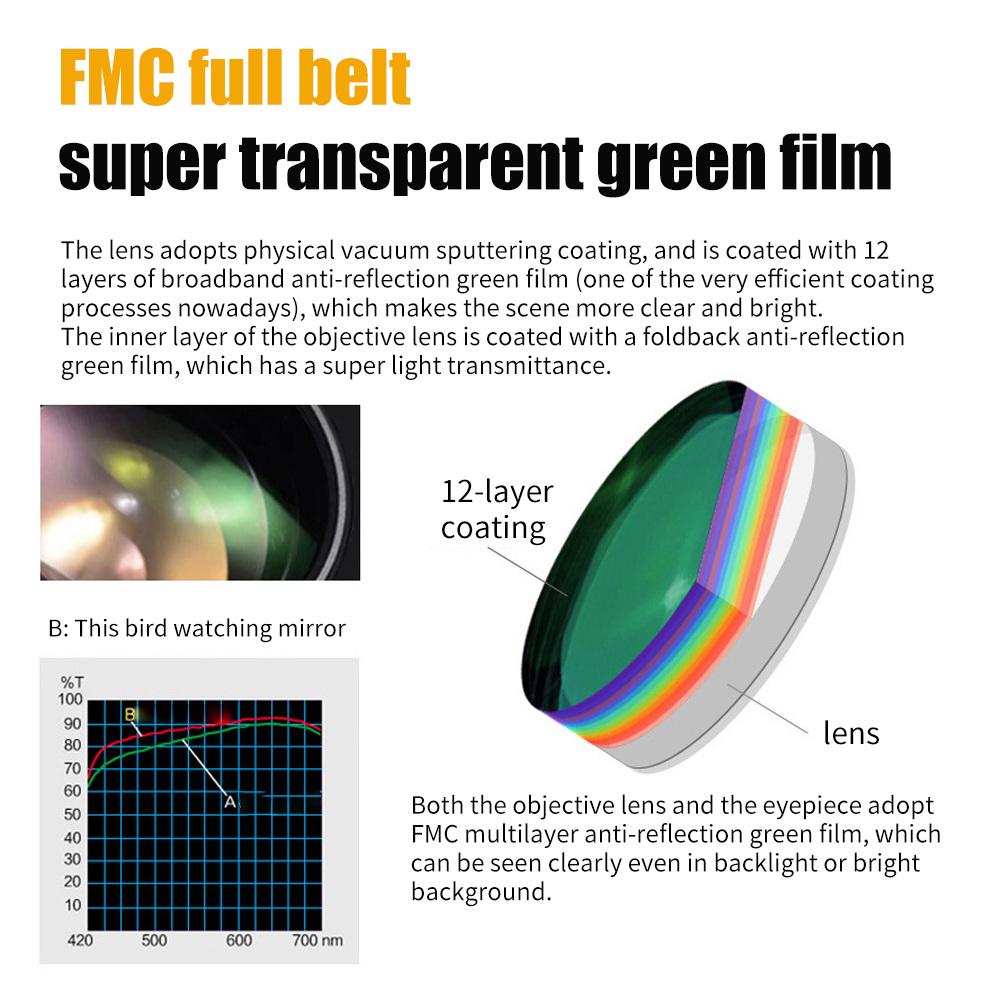If you’ve reached the point where your binoculars no longer provide the level of magnification you need, it might be time to upgrade to a spotting scope. With so many different options on the market, selecting the right scope can be overwhelming. In this article, we’ll cover the basics of choosing a spotting scope and offer guidance to help you find the best fit for your needs.

So, what kinds of models do spotting scopes have? Well, they mainly fall into two big types. One is fixed magnification, which means the magnification stays the same all the time. The other is variable magnification, where you can adjust the magnification as you like. Mostly, what we usually come across are those variable-magnification spotting scopes. You know why they’re so popular? It’s because you can first use a low magnification to find where the birds are, and then just turn it up to a high magnification to check out all the details of the birds. But, there’s a downside to these variable-magnification ones. When you set them at the same magnification as the fixed ones, you’ll get a smaller field of view and sometimes the image might even be distorted. But now there are also solutions to solve the problems of fixed and zoom. I will take you to learn more about it later. These magnifications are usually printed on the product for easy identification. When looking at spotting scopes, binoculars, or rifle scopes, you’ll notice that they are all identified by two key numbers: the magnification and the diameter of the objective lens. Let’s break this down with an example:
20-60×80 Spotting Scope
- The first number (20-60) indicates the magnification In this case, the scope can zoom from 20xmagnification (20 times larger than the naked eye) to 60x magnification (60 times larger than the naked eye).
- The second number (80) refers to the diameter of the objective lensin millimeters. A 80mm lens allows more light to enter the scope, resulting in a brighter image.
Not all spotting scopes offer a zoom feature, but many, like the one above do. The magnification can be adjusted within the specified range, allowing you to tailor the view to your needs.
Magnification: More Isn’t Always Better
Now that you understand the basic numbers, let’s talk about magnification. You may think that the higher the magnification, the better—but that’s not always the case. While magnification like 60x might sound impressive, it can come with significant drawbacks.
Challenges with High Magnification:
1.Image Instability: Anything above 10x magnification on a handheld scope can lead to a shaky image, as human hands naturally tremble. For magnifications above 10x, you’ll need a tripod to stabilize the image.
2.Narrow Field of View: As magnification increases, the field of view decreases, making it harder to locate and track objects.
3.Darker Images: Higher magnification requires more light, which can lead to dimmer images unless you’re using a large objective lens.
4.Reduced Image Quality: Atmospheric conditions, such as haze, mist, or heat distortion, can negatively affect image clarity at high magnifications.
5.Optical Integrity: Unless you’re investing in a high-quality scope, image sharpness and clarity can suffer at higher magnifications.
Spotting Scope Eyepieces: Fixed vs. Zoom
When it comes to eyepieces, some spotting scopes come with fixed eyepieces (like the 12×60 scope) which offer clearer images at lower magnifications, while others come with zoom eyepieces (like the 20-60×80) that allow you to adjust the magnification. Zoom eyepieces give you more flexibility. So, Do you know if there are any spotting scopes that can do both zoom and fixed magnification? Well, there are. the answer is Detachable Eyepiece Spotting Scopes. Take the SECOZOOM’s 28-84×118 spotting scope for example. It’s got two eyepieces. One is a 30x fixed magnification eyepiece, and the other is a 28-84 variable magnification one. And you can switch between these two eyepieces really fast, which makes it super easy to spot your target quickly. It’s a great option.
Weather Conditions and Other Factors
Even the best spotting scopes can struggle under poor weather conditions. Wind, humidity, and heat mirage can all distort the image. On days when the weather isn’t ideal, you might find that your binoculars are better suited for the job. While spotting scopes offer superior magnification, they should be used in conjunction with binoculars, not as a replacement. Binoculars offer a quick, portable way to scan your surroundings, while spotting scopes are best for more detailed observations at longer distances.
What’s Most Important When Choosing a Spotting Scope?
If magnification isn’t the most important factor, what should you prioritize? The key is to look for clear, bright images with minimal chromatic aberration—especially at longer distances. The biggest challenge in remote observation is blue light. This is produced by the refraction of light through many lenses. The professional name is chromatic aberration.
What Is Chromatic Aberration?

As shown in the figure, Chromatic aberration occurs when a lens fails to focus all colors of light at the same point, resulting in color fringing at the edges of objects. High-quality scopes often use Extra-Low Dispersion (ED) glass to combat this effect and improve image clarity. To ensure a brighter, sharper image, look for scopes with excellent light transmission properties. ED glass is commonly used in high-end scopes, while BAK-4 glass is a premium material for prisms, offering less chromatic aberration and better light transmission. BK-7 glass, though still good, has slightly more imperfections and is typically found in lower-end models. There’s another way that can cut down on chromatic aberration. That is to use cemented lenses. You see, by sticking several lenses with different refractive indexes together, the refractive index of light in different wavebands can be changed. Sure, it’s not as good as the effect of ED glass, but it’s a cheap way to do it. You gotta know, just one 80mm ED lens can cost up to 40 US dollars. That’s exactly why spotting scopes with ED lenses are so pricey. But even those ED spotting scopes can’t get rid of chromatic aberration completely. They can only make it less. And for high-magnification spotting scops, this doesn’t really matter much.


Lens Coatings
Good lens coatings can further enhance light transmission. making the field of view brighter. Fully Multi-Coated (FMC) lenses are ideal, as they offer multiple layers of coatings to reduce glare and improve clarity. Scopes with FMC coatings tend to provide better image quality in low-light conditions.

Waterproof Spotting Scopes
If you’re investing in a good spotting scope, consider getting a waterproof model. Waterproof scopes are filled with inert gases like argon or nitrogen, which prevent fogging and protect the internal components from dust and moisture. O-ring seals further ensure that no water or debris gets inside.
Whether you’re a casual observer or a serious enthusiast, choosing the right spotting scope will enhance your viewing experience and open up new possibilities for long-range observations. But If you don’t usually go outside or don’t really need to use it when it’s raining, there’s no point in splurging on features that you’ll never use.
What Size Spotting Scope Do You Need?
Now that you understand the fundamentals, let’s break down which scope size is ideal for various distances. While magnification is important, optical quality and light transmission should be your primary considerations. Here’s a general guide to choosing the right scope for different ranges:
For 25 to 75 Yards:
At this range, binoculars might suffice, but if you prefer a spotting scope, choose one with lower magnification and better-quality optics:
- Magnification:8-24x, 10-25x, 12-30x
- Lens Coatings:Fully Multi-Coated (FMC)
- Close Focus:Less than 25 feet
- Objective Lens Diameter:Larger is better for a brighter image.
For 100 Yards:
At 100 yards, a magnification between 20x and 40x is sufficient. A tripod will be needed for stability.
- Magnification:10-30x, 18-36x, 15-45x, 16-48x
- Lens Coatings:FMC
- Tripod:Required for steady images.
For 200 Yards:
At 200 yards, you’ll need higher magnification and better clarity:
- Magnification:20-40x, 20-60x
- Lens Coatings:Fully multi-coated (FMC)
- Tripod:Essential for stability.
- Prism Glass:BAK-4 is the best.
For 300 Yards:
At this range, you’ll need higher magnification and superior image quality:
- Magnification:20-60x, 20-80x
- Objective Lens Diameter:60mm to 80mm
- Lens Coatings:FMC
- Prism Glass:BAK-4
- Tripod:Absolutely necessary.
- Dual Focus:Ideal for fine-tuning image clarity.
For 500 Yards:
For distances of 500 yards, you need top-tier optics:
- Magnification:20-60x, 20-80x
- Objective Lens Diameter:60mm to 80mm
- Lens Coatings:FMC
- Prism Glass:BAK-4
- Lens Glass:Extra-low dispersion (ED) glass
- Tripod:A sturdy tripod is a must.
- Dual Focus:Essential for precise adjustments.
For 1000 Yards:
To observe at distances of 1000 yards, only the best scopes will suffice:
- Magnification:20-60x, 20-80x
- Objective Lens Diameter:80mm or more
- Lens Coatings:FMC
- Prism Glass:BAK-4
- Lens Glass:Extra-low dispersion (ED)
- Tripod:A heavy-duty tripod is essential.
- Dual Focus:Fast or dual focus systems are necessary for clarity.
Conclusion: What Is the Best Size Spotting Scope?
While magnification is important, optical quality—especially the type of glass and coatings—is far more crucial for image clarity. You don’t need to buy the most expensive scope, but you do need to balance magnification with high-quality optics and a lens system that will provide bright, sharp images. Be sure to choose a scope that suits the distance you plan to observe, and always prioritize light transmission and optical quality.












